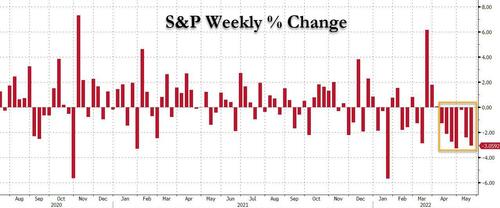"80% Chance Of Dread": Every Time This Happened Before, The Fed Bailed Out The Market
With stock futures set to rebound today - at least until the rip sellers re-emerge on this $1.9 trillion op-ex day - absent a 3% surge, stocks are set for a 7th consecutive week of declines...

... the longest such stretch since 2001.

And while traders are fixated on what today's op-ex delivers, others are turning their attention to the furious Wednesday selloff - and subsequent Thursday drop - and what it suggests for markets and the economy.
As Bloomberg's Ven Ram writes, while economists are frantically trying to figure out the probability of a recession, stock traders are at least sensing some kind of alarm. According to the BBG Markets Live commentator, while in more “normal” times, you would expect that a 4% selloff in the S&P 500 Index to lure buyers who were earlier on the sidelines, this time around that did not happen.
Ram set up a backtest to check this out, parsing data from the start of the millennium, with the null hypothesis being that all significant declines are followed by a bounce-back, however minuscule. There have only been 40 instances when we have seen a selloff matching the threshold of a 4% -- or greater -- single-day decline. Statistically, that means if you trade stocks for 1,000 consecutive days, you may witness such an occasion on just seven such days. (Before the global financial crisis, there were only four such instances since the start of the test period!)
Here is the interesting part: on most occasions when stocks sold off on that scale, investors bought back enough on the following day to push the S&P 500 Index into positive territory. However, that failed to happen on Thursday.
According to Ram, that is incredibly rare "and has mostly happened when the U.S. economy has faced a stern test of character: during the bursting of the dotcom bubble, the global financial crisis and the first wave of the pandemic as the table below shows."

And here an even more remarkable fact: of the 40 occasions the selloff exceed 4%, there have been only 14 instances when it hasn’t been greeted with follow-through buying (excluding this week). On only three of those occasions were the findings not coincidental to - or heralding - something being seriously amiss with the economy, "meaning traders are ascribing a near-80% chance of spotting something dreadful."
As Ram concludes, "clearly, Wednesday’s slump was about more than just another correction amid the Fed’s continuing interest-rate increases. If it had been, investors would have waded right back in to swoop in and benefit from what they may have perceived as beaten-down valuations." The fact that didn’t happen prompts the Bloomberg commentator to speculate that traders are probably factoring in a collapse in earnings growth that may coincide with a sharp slowdown in the economy, or worse, a recession.
There is another read of the above: on all previous "plunge and non-bounce" occasions, the Fed stepped in: to end the Great Financial Crisis, the Fed launched QE; to end the 2011 "US downgrade" rout, the Fed announced Operation Twist; to reverse the 2020 Covid Crash, the Fed went all in with trillions in QE, Repos and bond purchases.
Will it really do nothing this time and leave the market to crash, dragging both the US and global economy down with it?
Yes, the S&P cratering from here will kill deflation... it will also spark the biggest depression in U.S. history. And while it may not have crossed the minds of Biden's handlers, a second great depression may be even worse for the Democrats' approval rating than hyperinflation...
Disclosure: Copyright ©2009-2022 ZeroHedge.com/ABC Media, LTD; All Rights Reserved. Zero Hedge is intended for Mature Audiences. Familiarize yourself with our legal and use policies every ...
moreComments
 No Thumbs up yet!
No Thumbs up yet!



